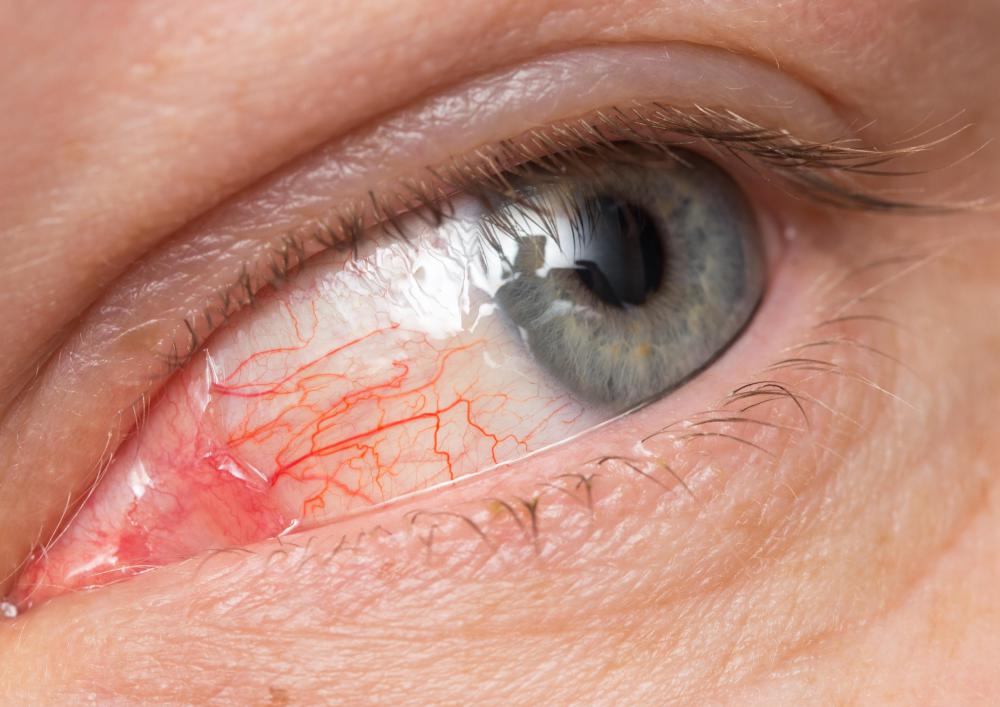At AllThingsNature, we're committed to delivering accurate, trustworthy information. Our expert-authored content is rigorously fact-checked and sourced from credible authorities. Discover how we uphold the highest standards in providing you with reliable knowledge.
What Is Epiphora?
When excess tears are unable to drain properly, they will often drip down the face. This condition is known as epiphora, and although it can occur in humans and other animals, it is more commonly seen in dogs. Brownish colored tear tracks on the face are typically one of the most common symptoms of this condition. These tear stains can be removed, but it is also important to treat the underlying cause of this condition. Some common causes of epiphora include blocked tear ducts or eye infections.
Natural tears are necessary for lubricating the eyes. They help the eyelids glide over the eyeballs, and they also help wash dirt and other debris out of the eyes. Normally, extra tears drain into the nasal passages through the nasolacrimal ducts, which are tiny tubes located in the corners of the eyes near the nose.

Epiphora occurs when tears are unable to drain into the nasal passages. Instead, they will overflow out of the eyes and run down the cheeks. Depending on the cause, this can occur in one or both of the eyes. It is also referred to as watering eye or tearing.
Epiphora can occur in humans, but it is generally more apt to occur in domestic animals, particularly dogs. Tear stains are typically the most common symptom of epiphora in dogs. These stains can be seen under the inner corners of the eyes and down the sides of the face.

Tear stains caused by epiphora are typically brown or rust colored. This color is not caused by the tears themselves, but from micro-organisms that grow in this area. The dampness and warmth caused by the overflowing tears are ideal conditions for a certain type of yeast to grow.
Other symptoms of epiphora may also be present as well. For example, some dogs may have a pus-like discharge from the eyes. This may even dry and become crusty. Some dogs may also have red, irritated eyes.
Removing tear stains caused by this condition can be somewhat difficult. Some dog owners choose to dab hydrogen peroxide on the eyes and tear stains. This can not only remove the stain, but it can also kill harmful micro-organisms that may infect the area. Although it may help remove the staining, this method is not considered to be a treatment for this condition.
Epiphora treatment will typically depend on the underlying cause of the condition. Generally, the most common cause of epiphora is blocked nasolacrimal ducts. These ducts can become blocked by an infection or tiny foreign particles. Epiphora can also be caused by excessive tear production.
Frequently Asked Questions
What exactly is epiphora in animals?
Epiphora is a medical condition characterized by the excessive tearing or overflow of tears onto the face. It can occur in both humans and animals, often resulting from irritation or blockage of the animal's tear ducts. In pets like dogs and cats, it's commonly seen as wet streaks beneath the eyes.
What causes epiphora in pets?
Epiphora in pets can be caused by a variety of factors, including congenital abnormalities (like narrow tear ducts), infections, allergies, eye injuries, or even entropion, where the eyelid rolls inward. According to the American College of Veterinary Ophthalmologists, it's essential to identify the underlying cause to determine the appropriate treatment.
How can I tell if my pet has epiphora?
Signs of epiphora include noticeable tear stains, dampness around the eyes, redness, or even skin irritation from constant moisture. In some cases, you may also observe your pet pawing at their face or squinting, which indicates discomfort. A veterinary examination is crucial for an accurate diagnosis.
Is epiphora painful for animals?
While epiphora itself is not necessarily painful, the underlying conditions causing excessive tearing can cause discomfort or pain. For instance, if epiphora is due to an infection or an eyelid issue like entropion, your pet may experience significant discomfort that requires veterinary attention.
Can epiphora lead to other health issues in animals?
Yes, if left untreated, epiphora can lead to skin irritation or infection due to the constant wetness. Chronic wetness can also create a breeding ground for yeast and bacteria, potentially leading to more severe conditions like dermatitis, according to veterinary dermatology studies.
What treatments are available for epiphora in animals?
Treatment for epiphora depends on the underlying cause. If it's due to an infection, antibiotics may be prescribed. For structural issues like narrow tear ducts, surgery might be necessary. In cases of allergies, removing the allergen and administering antihistamines can help. Always consult a veterinarian for a treatment plan tailored to your pet's specific needs.
AS FEATURED ON:
AS FEATURED ON:












Discuss this Article
Post your comments